Team:LMU-Munich/Cut'N'survive/Functional Principle
From 2010.igem.org
(Difference between revisions)
(→Case b) the plasmid has been incorporated) |
|||
| (12 intermediate revisions not shown) | |||
| Line 1: | Line 1: | ||
{{:Team:LMU-Munich/Templates/Page Header}} | {{:Team:LMU-Munich/Templates/Page Header}} | ||
| - | + | [[Image:cnsZelle.png|300px|Logo|right]] | |
| - | The | + | |
| + | |||
| + | |||
| + | |||
| + | == Cut'N'Survive-System == | ||
| + | |||
| + | The Cut'N'Survive-System combines several proteins with specific properties to select eukaryotic cells incorporating the target plasmid by apoptosis. Two DNA constructs are needed and one of them (construct 1) should be integrated in the cell's genome. | ||
=== Construct 1 === | === Construct 1 === | ||
| - | Construct 1 contains the | + | Construct 1 contains the subsequent parts in the following order: |
Tetracyclin-inducible promoter, TEV-recognition site, N-degron, SF3b155, human bak and SV40 Polyadenylation site. | Tetracyclin-inducible promoter, TEV-recognition site, N-degron, SF3b155, human bak and SV40 Polyadenylation site. | ||
| - | [[Image: | + | [[Image:cutwik32.jpg|600pxs|TEVdegron-System: TEV-degron-System]] |
| - | To | + | To select cells with this construct integrated into the cellular genome we perform a co-transfection with hygromycine resistence plasmid. The TEV-recognition site will be cut by the TEV-protease which is part of construct 2. Due to the digestion at the TEV-recognition site, the N-terminus of N-degron is free and thus provides a signal for the degeneration of the protein. SF3b155 is a protein interacting with p14* from construct 2. This interaction ascertains that the TEV-protease of construct 2 is being brought to the recognition site. The human bak is an efficient apoptosis inducing membrane protein. |
=== Construct 2 === | === Construct 2 === | ||
| Line 18: | Line 24: | ||
Construct 2 is composed of CMV-promoter, TEV-protease, p14, TEV-recognition site, eGFP, a double stop codon and SV40PA. | Construct 2 is composed of CMV-promoter, TEV-protease, p14, TEV-recognition site, eGFP, a double stop codon and SV40PA. | ||
| - | [[Image: | + | [[Image:cutwik.jpg|600pxs|TEVdegron-System: TEV-degron-System]] |
| - | The CMV-promoter is | + | The CMV-promoter is for the expression of construct 2. The task of TEV-protease is to cut TEV-recognition sites, both the one upstream of N-degron to trigger protein degradation and the one upstream of the target gene (eGFP in this case) to ensure that the wanted product is not degraded. p14* is interacting with SF3b155 and so increases the rate of specific digestion at the TEV-recognition site by the TEV-proteases. eGFP is an example of a gene of interest which can conveniently be verified by green fluorescence. |
=== Selection === | === Selection === | ||
| - | A cellline which | + | A cellline which is stably integrated with construct 1 and is transfected with construct 2 can contain the following two kinds of cells: |
| - | a) | + | a) cells not incorporated with construct 2 |
| - | b) | + | b) cells incorporated with construct 2 |
These lead to the following consequences. | These lead to the following consequences. | ||
| - | ==== Case a) | + | ==== Case a) cells not incorporated with construct 2==== |
| - | After induction of the tet-on promoter construct 1 will be translated into protein. The bak- | + | After induction of the tet-on promoter construct 1 will be translated into protein. The bak-protein will integrate into mitochondrial membrane and as a result induces apoptosis. |
| - | ==== Case b) | + | ==== Case b) cells incorporated with construct 2 ==== |
| - | Construct 2 will be read off and | + | Construct 2 will be read off and after introduction of doxycycline the tet-on promoter will trigger the translation of construct 1 into protein. However in this case the TEV proteases will instantly separate eGFP from the rest of the protein as well as free the N-terminus of N-degron. This will cause the degradation of the whole protein complex - including bak. Therefore the cell will survive and only the protein product of the gene of interest will be left. |
| - | [[Image: | + | [[Image:cutwiki4.jpg|600px|TEVdegron-System: TEV-degron-System]] |
| + | [[Image:cutwik5.jpg|600px|TEVdegron-System: TEV-degron-System]] | ||
| + | [[Image:cnsZelle.png|300px|Logo|right]] | ||
Latest revision as of 14:39, 25 October 2010


![]()
![]()







![]()
 "
"






